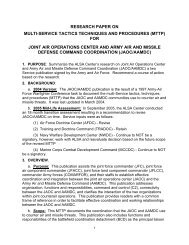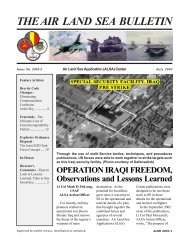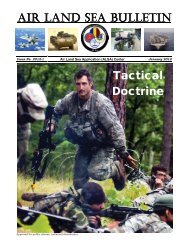AIR LAND SEA BULLETIN Attack the Network - ALSA
AIR LAND SEA BULLETIN Attack the Network - ALSA
AIR LAND SEA BULLETIN Attack the Network - ALSA
Create successful ePaper yourself
Turn your PDF publications into a flip-book with our unique Google optimized e-Paper software.
… doctrine, organization,<br />
training, and materialdevelopment<br />
is progressing.<br />
<strong>ALSA</strong><br />
(Air Land Sea<br />
Application) Center<br />
is preparing<br />
a multi-Service<br />
Tactics Techniques<br />
and<br />
Procedures publication<br />
on<br />
biometrics.<br />
(e.g., in Afghanistan <strong>the</strong> Threat<br />
Finance Cell of <strong>the</strong> DEA working with<br />
<strong>the</strong> Afghans on court authorized wire<br />
intercepts).<br />
HIGHER HEADQUARTERS LEPS<br />
LEPs at higher HQ work with<br />
<strong>the</strong> various enablers (i.e., labs or<br />
o<strong>the</strong>r agencies) and ―reach back‖<br />
entities such as <strong>the</strong> Counter-IED<br />
Operations Integration Center or<br />
National Ground Intelligence Center<br />
to help complete <strong>the</strong> intelligence picture<br />
of <strong>the</strong> IED threat by requesting<br />
products such as biometric focused<br />
area studies, overlays of latents of<br />
value, and o<strong>the</strong>rs. They ensure<br />
deoxyribonucleic acid (DNA) and<br />
latents of value lab results exploited<br />
from IED events are returned to <strong>the</strong><br />
submitting units (in <strong>the</strong> field). Often<br />
<strong>the</strong>se results are published to a<br />
<strong>the</strong>ater-wide data base (e.g., <strong>the</strong><br />
Combined Information Data <strong>Network</strong><br />
Exchange) with which units in <strong>the</strong><br />
field have limited or no connectivity.<br />
When latent matches are<br />
made and bomb makers and IED<br />
placers are identified, <strong>the</strong> higher HQ<br />
LEPs assist by printing and distributing<br />
be-on-<strong>the</strong>-look-out (BOLO)<br />
messages to host nation security<br />
forces through <strong>the</strong> battalion LEPs.<br />
These are also placed in books to<br />
which units on <strong>the</strong> ground can have<br />
access while on patrols and during<br />
operations. The higher HQ LEPs act<br />
as catalysts in developing<br />
information on financial networks<br />
and dispersing it to <strong>the</strong> appropriate<br />
host nation enti-ties working in with<br />
o<strong>the</strong>r US agencies for fur<strong>the</strong>r<br />
investigation and action.<br />
CURRENT SUCCESSES,<br />
CHALLENGES, AND WAY AHEAD<br />
Overall, <strong>the</strong> LEP program has<br />
enjoyed generally positive reviews in<br />
after-action reports and lessons learned<br />
summaries. LEPS support to connecting<br />
individual IED makers and<br />
placers through DNA and fingerprints,<br />
forwarding BOLOs, and encouraging<br />
units to collect biometric<br />
data in <strong>the</strong>ir area of operations, has<br />
ALSB 2012-2 28<br />
been successful. However, challenges<br />
remain in realizing <strong>the</strong> LEP program’s<br />
potential in <strong>Attack</strong> <strong>the</strong> <strong>Network</strong><br />
operations.<br />
The first challenge is <strong>the</strong> manpower<br />
requirement to fully develop<br />
<strong>the</strong> network picture. An LEP recently<br />
stated, ―<strong>Attack</strong> <strong>the</strong> <strong>Network</strong>… is just<br />
too difficult without a dedicated<br />
squad of investigators.‖<br />
A second challenge is ensuring<br />
processed information is available to<br />
<strong>the</strong> lowest units in a timely manner.<br />
Bandwidth issues and understanding<br />
where information is required remain<br />
problematic.<br />
The third challenge is forensic<br />
lab capacity to process evidence. The<br />
same LEP noted, ―<strong>the</strong> lab is backed<br />
up [with] some 400 DNA cases‖.<br />
The fourth challenge is reliability<br />
of biometric collection tools.<br />
The LEP noted again ―We had a lot of<br />
trouble with <strong>the</strong> Handheld Interagency<br />
Identity Detection Equipment<br />
today, and it just took too long to<br />
enter <strong>the</strong> 15 (people’s data)‖.<br />
With <strong>the</strong> recent withdrawal<br />
from Iraq and <strong>the</strong> impending drawdown<br />
in Afghanistan, many questions<br />
about <strong>the</strong> future of <strong>the</strong> LEP<br />
program emerge. Will LEPs become a<br />
formal capability set within service<br />
structure? Will it fade away with our<br />
redeployments? Can <strong>the</strong> LEP program<br />
fulfill its potential? Will it be<br />
needed in <strong>the</strong> future? Can it be<br />
applied to operations outside COIN?<br />
While those questions remain,<br />
in <strong>the</strong> short term, doctrine, organization,<br />
training, and material development<br />
is progressing. <strong>ALSA</strong> (Air<br />
Land Sea Application) Center is<br />
preparing a multi-Service Tactics<br />
Techniques and Procedures publication<br />
on biometrics. Ground forces<br />
continue to form and train with<br />
LEPS. The industry continues to develop<br />
new and improved biometric<br />
equipment. For now LEPS continue<br />
to provide critical support to COIN<br />
operations.





